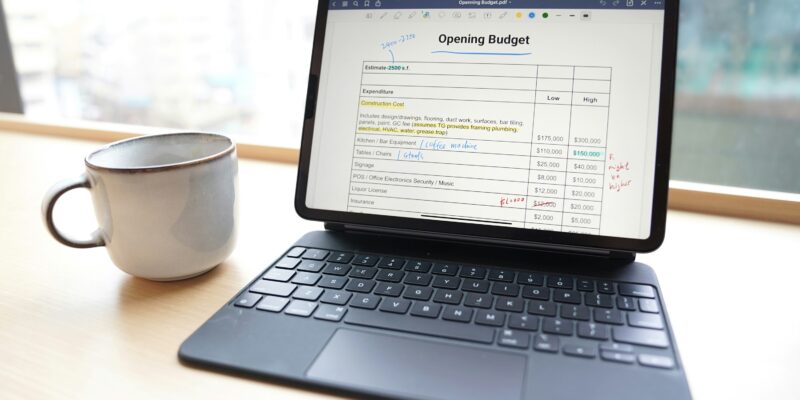
When you hear the word “budget,” do you cringe a little? Many people think budgeting means giving up all the fun stuff—no lattes, no Friday takeout, no joy. But here’s the truth: budgeting isn’t about restriction; it’s about empowerment. A smart budget lets you take control of your money, maximize your income, and save for the things that truly matter.
Let’s dive into actionable, easy-to-follow budgeting tips that will transform your financial life without making you feel like you’re living in a shoebox.
Tip 1: Know Where Your Money Goes
The first step to smart budgeting is understanding your current spending habits. Think of it as an audit—but way less boring.
Actionable Steps:
- Track Every Dollar:
Use an app like Mint, PocketGuard, or YNAB to see where your money goes.- Example: You might discover you’re spending $200 a month on delivery apps. Time to fire up the stove!
- Categorize Your Expenses:
Group spending into categories like rent, groceries, subscriptions, and entertainment.
Pro Tip: Don’t judge yourself during this step. This is about awareness, not guilt.
Tip 2: Embrace the 50/30/20 Rule
This budgeting rule is popular for a reason: it’s simple and works for almost everyone.
Breakdown:
- 50% Needs: Rent, utilities, groceries, transportation.
- 30% Wants: Dining out, Netflix, hobbies.
- 20% Savings & Debt Repayment: Emergency fund, investments, paying down loans.
Example:
If you earn $3,000 per month:
- $1,500 goes to needs.
- $900 goes to wants.
- $600 goes to savings or paying off debt.
Tip 3: Automate Your Savings
Think of savings as a non-negotiable expense, like rent. When you automate it, you won’t be tempted to spend it.
Actionable Steps:
- Set up an automatic transfer from your checking account to savings every payday.
- Open a high-yield savings account to earn more interest.
Example:
Transfer $200 monthly into a savings account. In a year, that’s $2,400 without lifting a finger.
Tip 4: Cut Expenses Without Cutting Fun
You don’t have to give up everything you love to save money. Instead, look for areas where you can trim the fat.
Actionable Steps:
- Review Subscriptions: Are you still paying for that gym membership you stopped using last year? Cancel it.
- Shop Smart: Use cashback apps like Rakuten or Honey to save while shopping online.
- Cook More: Swap one takeout meal a week for a home-cooked dinner.
Example:
If you skip two $20 takeout meals per week, you’ll save $160 a month—or $1,920 a year!
Tip 5: Boost Your Income
A budget isn’t just about spending less—it’s also about earning more.
Actionable Steps:
- Pick up a side hustle: Try freelancing, selling on Etsy, or driving for a ride-share service.
- Sell unused items: Clean out your closet and sell items on platforms like eBay or Facebook Marketplace.
- Negotiate your salary: If you’re due for a raise, ask for one!
Example:
Earning an extra $300 per month from a side gig can supercharge your savings or debt repayment goals.
Tip 6: Plan for Irregular Expenses
Irregular expenses—like holiday gifts or car repairs—can wreck a budget if you’re not prepared.
Actionable Steps:
- Create a “sinking fund” for irregular expenses by setting aside a small amount each month.
- Divide annual costs into monthly contributions.
Example:
If you spend $1,200 on holiday gifts every year, save $100 per month starting in January.
Tip 7: Set Savings Goals That Excite You
Saving is easier when you know what you’re saving for.
Actionable Steps:
- Define your goal: A vacation, a new car, or an emergency fund.
- Break it into monthly savings targets.
- Visualize your progress: Use a savings tracker or chart.
Example:
Want to take a $3,000 vacation in a year? Save $250 a month and watch your dream trip become a reality.
Tip 8: Use the Envelope System (Even Digitally!)
If overspending is your Achilles’ heel, the envelope system can help.
Actionable Steps:
- Allocate cash (or digital equivalents) to specific categories like groceries or entertainment.
- When the envelope is empty, that’s it for the month.
Modern Twist: Use budgeting apps that mimic the envelope system, like Goodbudget.
Tip 9: Review Your Budget Regularly
Life changes, and so should your budget.
Actionable Steps:
- Set a “money date” with yourself each month to review your spending.
- Adjust categories as needed to reflect new priorities or income changes.
Example:
If you get a raise, increase your savings percentage instead of inflating your lifestyle.
Tip 10: Reward Yourself
Budgeting shouldn’t feel like punishment. Build small rewards into your plan to stay motivated.
Actionable Steps:
- Set milestones (e.g., saving $1,000) and reward yourself with something fun but reasonable (like a $20 splurge).
- Celebrate progress, no matter how small.
Example:
After paying off a credit card, treat yourself to a dinner out—you’ve earned it!
Recommended Books to Level Up Your Budgeting Skills
- “The Total Money Makeover” by Dave Ramsey
A no-nonsense guide to budgeting and building financial health. - “Your Money or Your Life” by Vicki Robin
A classic book on transforming your relationship with money. - “I Will Teach You to Be Rich” by Ramit Sethi
Packed with practical tips for managing money without feeling deprived. - “Smart Women Finish Rich” by David Bach
A straightforward guide to budgeting and investing for financial security. - “The Financial Diet” by Chelsea Fagan
A fun, approachable read for beginners in personal finance.
Final Thoughts
Smart budgeting isn’t about deprivation—it’s about aligning your money with your priorities. When you create a budget that works for your lifestyle, you’ll feel in control, reduce stress, and have more room to save for the things you care about most.
Start small. Track your expenses, automate your savings, and make a few tweaks to your spending. You’ll be amazed at how quickly your financial picture improves. Remember, every dollar you budget is a step closer to the life you want. Happy budgeting!















